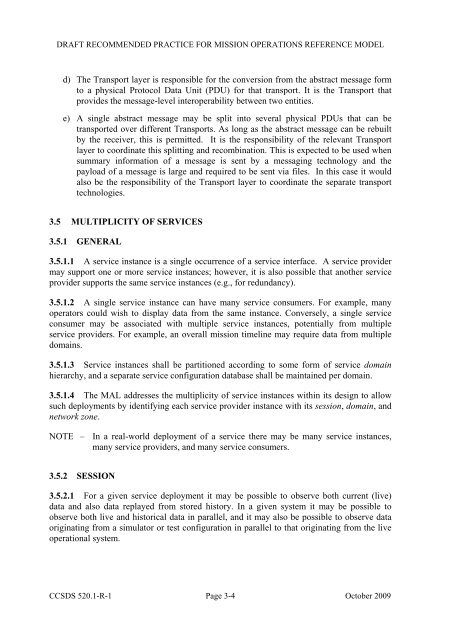Mission Operations Reference Model. Draft ... - CCSDS
Mission Operations Reference Model. Draft ... - CCSDS
Mission Operations Reference Model. Draft ... - CCSDS
Create successful ePaper yourself
Turn your PDF publications into a flip-book with our unique Google optimized e-Paper software.
DRAFT RECOMMENDED PRACTICE FOR MISSION OPERATIONS REFERENCE MODELd) The Transport layer is responsible for the conversion from the abstract message formto a physical Protocol Data Unit (PDU) for that transport. It is the Transport thatprovides the message-level interoperability between two entities.e) A single abstract message may be split into several physical PDUs that can betransported over different Transports. As long as the abstract message can be rebuiltby the receiver, this is permitted. It is the responsibility of the relevant Transportlayer to coordinate this splitting and recombination. This is expected to be used whensummary information of a message is sent by a messaging technology and thepayload of a message is large and required to be sent via files. In this case it wouldalso be the responsibility of the Transport layer to coordinate the separate transporttechnologies.3.5 MULTIPLICITY OF SERVICES3.5.1 GENERAL3.5.1.1 A service instance is a single occurrence of a service interface. A service providermay support one or more service instances; however, it is also possible that another serviceprovider supports the same service instances (e.g., for redundancy).3.5.1.2 A single service instance can have many service consumers. For example, manyoperators could wish to display data from the same instance. Conversely, a single serviceconsumer may be associated with multiple service instances, potentially from multipleservice providers. For example, an overall mission timeline may require data from multipledomains.3.5.1.3 Service instances shall be partitioned according to some form of service domainhierarchy, and a separate service configuration database shall be maintained per domain.3.5.1.4 The MAL addresses the multiplicity of service instances within its design to allowsuch deployments by identifying each service provider instance with its session, domain, andnetwork zone.NOTE – In a real-world deployment of a service there may be many service instances,many service providers, and many service consumers.3.5.2 SESSION3.5.2.1 For a given service deployment it may be possible to observe both current (live)data and also data replayed from stored history. In a given system it may be possible toobserve both live and historical data in parallel, and it may also be possible to observe dataoriginating from a simulator or test configuration in parallel to that originating from the liveoperational system.<strong>CCSDS</strong> 520.1-R-1 Page 3-4 October 2009
















